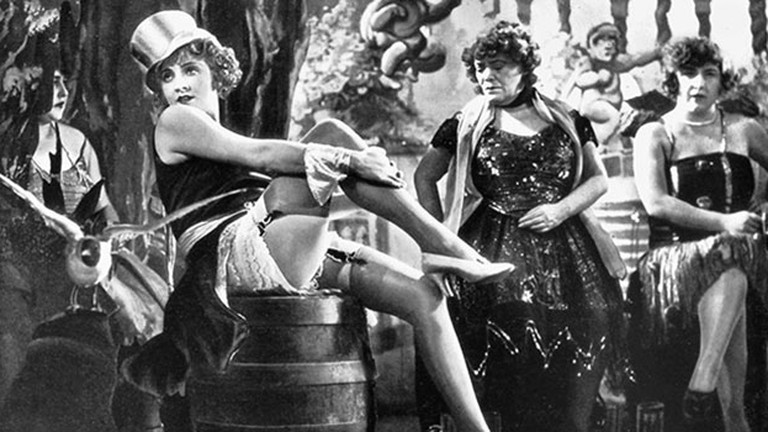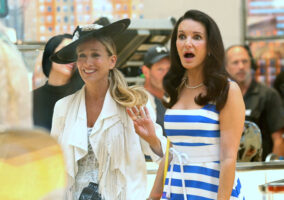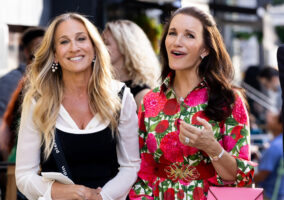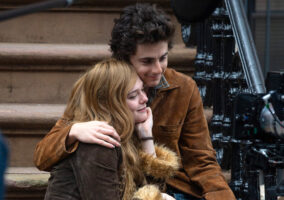![]() Pin
Pin
When Liza Minnelli performed “Mein Herr” in 1972’s Cabaret wearing a halter vest, short-shorts, a derby, garters and lace-up boots, she not only created an indelible cinema moment and helped secure her Oscar for Best Actress, but she served up a look so unforgettable, so tied to her own image, so easy to replicate and make reference to, that there’s no question the costume has gone on to become one of the most iconic in film history. What’s interesting about this look is how it has become a sort of shorthand not only for Minnelli herself but for the film’s director, legendary choreographer Bob Fosse, who knew a thing or two about how to make a derby look sexy.
As a number, it still slaps, nearly a half-century later. Fosse’s issues with women play out exquisitely in the extremely precise and restrained choreography (which nonetheless manages to portray the dancers as devious, dirty, sinister beings), and Liza is simply on fire, which does tend to ask a lot of the audience, because we’re supposed to believe that no one in the club can see the talent in front of them, not even the emcee. A lot of people consider the “Cabaret” number or perhaps even “New York, New York” to be her signature song, but it seems to us that this is the number – and more specifically, the image – most associated with Minnelli when she was at the top of her game.
![]() Pin
Pin
![]() Pin
Pin
What interests us about this costume is how it paid the bare minimum deference (a tip of the hat, you might say) to historical accuracy, but was as much about the time in which the film was made as it was the time in which the film was set. In other words, from 2020, this look reeks of the seventies, not Berlin in the thirties.
![]() Pin
Pin
![]() Pin
Pin
Minnelli’s eye makeup, glittery green nail polish, hot pants, sequined crotch and platform boots are all right on the verge of becoming de riguer among the pop star set in 1972. You could see almost all of these trends modeled extensively (by both men and women at the height of glam rock) on any given episode of American Bandstand at the time the film came out – and for a good many years after. And the combination of lingerie and menswear is something that female pop stars have been playing with almost continuously in the nearly five decades since this costume debuted. In other words, everyone from Bowie to Madonna is caught up in the mix here.
![]() Pin
Pin
![]() Pin
Pin
The genius of costume designer Charlotte Flemming’s work here is how it perfectly encapsulates the Fosse aesthetic (Despite the dim lighting and dark color, it’s impossible not to register every movement of her body, from the twisting of her torso to the flailing of her arms, the tipping of her hat to the straddling of the chair), perfectly captures where popular fashion was heading in the 1970s, tells you most of what you need to know about Sally Bowles, and pays homage to her iconic cinematic forebear all at the same time.
![]() Pin
Pin
![]() Pin
Pin
Despite the seventies-trendiness of the look, there are markers that place it in a certain time and place (Berlin, 1931). There’s definitely a sense of post-Weimar decadence in the look – and as we’ll see in a second, there’s reason to consider menswear tropes blended with women’s undergarments to be appropriate for a German cabaret in the ’30s.
![]() Pin
Pin
![]() Pin
Pin
But Sally Bowles, despite Minnelli’s overwhelming charisma and talent, is not a major star; not seen as a major talent, and certainly isn’t on the cutting edge of the avant garde or the world of fashion. She is performing a dying art form in a dying regime on the verge of turning horrifyingly violent and destructive. From the film’s time and place, this is not a look that speaks of the future; it’s one that owes more to the past.
![]() Pin
Pin
![]() Pin
Pin
Sally is obsessed with film stars and when she’s not reading movie magazines, she’s paying homage to some of the fading names of the silent film era, which had just reached its end in the last year or so. Her severe bob and bangs are a reference to Louise Brooks and at one point in the film, she vamps and declares herself to be mimicking Clara Bow, who sported similarly bobbed hair and heavy eye makeup. This costume is of its time and place, but not quite; just as Sally is a person very much of her time and place, but not quite (an American trying to pass herself off as an international sensation in Europe). Both Sally and this costume are about facing the past rather than the future; holding onto something (the Weimar Republic, the silent film era, a past she never truly had) that hasn’t yet realized its own end.
![]() Pin
Pin
It should be noted that Minnelli has four songs in the film and her costumes for the other numbers differ drastically from this one. “Money” has her dressed in an outdated 1920s flapper style, while “Maybe This Time” and “Cabaret” dispensed entirely with any notion of being true to the period and basically put her in costumes appropriate for a 1970s variety TV special; a peasant blouse with bell bottoms and a purple fringed halter dress with a belly cutout. Of all her stage costumes in the film, this is the only one that nominally speaks to its time and place.
![]() Pin
Pin
In fact, there’s a very deliberate and overt reference to another legendary film costume here: the top hat, garter and bloomers worn by Marlene Dietrich in the 1930 German film Blue Angel, when she sings what would become her signature song “Falling In Love Again.”
 Pin
Pin
Note how the staging here is exactly the same as in the “Mein Herr” number: a small, claustrophobic and dingy-looking set, a performer in her underwear and a man’s hat singing about love in a cynical way, surrounded by other women dressed in, for lack of a better term, slutty or flashy clothes, who serve as a sort of bored chorus in response to the song. But note that Dietrich has all the markers of a 1930s costume (dancing shoes, satin cuffs, dress) as opposed to Minnelli’s more ’70s glam rock-inspired vest, hot pants and boots; her sequined crotch serving as a witty echo of Dietrich’s raised skirt.
![]() Pin
Pin
Fosse knew what he was doing when he staged his number the same way (paying homage to a classic scene, setting his film firmly in the same time, place and milieu). Note the staging when Dietrich sings a reprise of the song later in the film:
Straddling a chair, much in the same manner as Sally’s performance. Stepping into the film (and sidestepping the clear ’70s references) we could look at this in the same way that Sally references film stars like Clara Bow and Louise Brooks.
![]() Pin
Pin
![]() Pin
Pin
We could assume that Sally was more or less ripping her look and choreography off from a currently popular German film that may have been playing in the cinemas at roughly the time she started working at the Kit Kat Club. But The Blue Angel is a tragedy and the character of Lola Lola (Dietrich), while clearly depicted as the femme fatale Sally so desperately wants to be, is meant to be seen as a somewhat seedy, vulgar woman in the context of the times.
![]() Pin
Pin
![]() Pin
Pin
Which means that if Sally did appropriate her stage look and choreography from The Blue Angel, she either didn’t get what the film was saying or didn’t care because she was too enraptured by the look and the performance. Despite Liza’s clear through-the-roof talent, Sally is supposed to be seen as someone more sad than dazzling.
![]() Pin
Pin
![]() Pin
Pin
A girl with a good voice but no star quality and a lot of self-sabotaging behavior, constantly taking her look and style from the pages of the movie magazines – and in this case, completely missing the point of the character she was mimicking. As her erstwhile lover Brian notes in reference to her delusions of being a femme fatale, she’s “about as fatale as an after-dinner mint.”
![]() Pin
Pin
![]() Pin
Pin
We look at this number and see a dazzling talent wearing an iconic film look, but if we step inside the story, we can see this number and this costume are telling the tale of a never-was holding onto a vision of herself that no one else sees, mimicking the looks of film stars whose fame she’ll never reach. A dingy-glamorous tragedy.
[Stills: ABC Pictures via Tom and Lorenzo]
Lizzo in Mônot at the 2020 BET Awards: IN or OUT? Next Post:
Black-Owned Fashion Brand Spotlight: Kenneth Ize
-
 Pin
Pin
Sarah Jessica Parker and Kristin Davis Filming AND JUST LIKE THAT… in New York City
-
 Pin
Pin
Sarah Jessica Parker and Kristin Davis Filming AND JUST LIKE THAT… in New York City
-
 Pin
Pin
Timothée Chalamet and Elle Fanning Film A COMPLETE UNKNOWN in Hoboken, New Jersey
Please review our Community Guidelines before posting a comment. Thank you!
